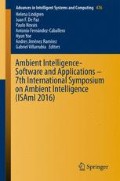Abstract
One of the main concerns in developed countries is population ageing. Elder people are susceptible of suffering conditions which reduce quality of life such as apraxia of speech, a burden that requires prolongued therapy. Our proposal is intended to be a first step towards automated solutions that assist speech therapy through detecting mouth poses. This work proposes a system for vowel poses recognition from an RGB-D camera that provides 2D and 3D information. 2D data is fed into a face recognition approach able to accurately locate and characterize the mouth in the image space. The approach also uses 3D real world measures obtained after pairing the 2D detection with the 3D information. Both information sources are processed by a set of classifiers to ascertain the best option for vowel recognition.
Access this chapter
Tax calculation will be finalised at checkout
Purchases are for personal use only
Preview
Unable to display preview. Download preview PDF.
References
Altman, N.S.: An introduction to kernel and nearest-neighbor nonparametric regression. The American Statistician 46(3), 175–185 (1992)
Friedman, N., Geiger, D., Goldszmidt, M.: Bayesian Network Classifiers. Mach. Learn. 29(2–3), 131–163 (1997)
Gerstner, E., Lazar, R., Keller, C., Honig, L., Lazar, G.S., Marshall, R.: A Case of Progressive Apraxia of Speech in Pathologically Verified Alzheimer Disease. Cognitive & Behavioral Neurology 20(1), 15–20 (2007)
Hall, M., Frank, E., Holmes, G., Pfahringer, B., Reutemann, P., Witten, I.H.: The WEKA data mining software: an update. SIGKDD Explor. Newsl 11(1), 10–18 (2009)
Hastie, T., Tibshirani, R., Friedman, J.: The Elements of Statistical Learning, 2nd edn., pp. 587–588. Springer (2008)
Holte, R.C.: Very Simple Classification Rules Perform Well on Most Commonly Used Datasets. Mach. Learn. 11(1), 63–90 (1993)
Lowe, D.G.: Object recognition from local scale-invariant features. In: ICCV, vol. 2, pp. 1150–1157 (1999)
Marti, P., Bacigalupo, M., Giusti, L., Mennecozzi, C., Shibata, T.: Socially assistive robotics in the treatment of behavioural and psychological symptoms of dementia. In: Biomedical Robotics and Biomechatronics, BioRob, pp. 483–488 (2006)
Milborrow, S., Nicolls, F.: Active Shape models with sift descriptors and mars. In: VISAPP, vol. 2, pp. 380–387 (2014)
Naruniec, J.: Discrete area filters in accurate detection of faces and facial features. Image and Vision Computing 32(12), 979–993 (2014)
Olson, D.L., Delen, D.: Advanced data mining techniques. Springer Science & Business Media (2008)
Ozkan, S., Adapinar, D.O., Elmaci, N.T., Arslantas, D.: Apraxia for differentiating Alzheimers disease from subcortical vascular dementia and mild cognitive impairment. Neuropsychiatric Disease and Treatment 9, 947–951 (2013)
Prabhu, U., Seshadri, K.: Facial Recognition Using Active Shape Models, Local Patches and Support Vector Machines (2009). http://www.contrib.andrew.cmu.edu/~kseshadr/ML_Paper.pdf (Accessed February 6, 2016)
Quigley, M., Conley, K., Gerkey, B., Faust, J., Foote, T., Leibs, J., Ng, A.Y.: ROS: an open-source robot operating system. In: ICRA Workshop on Open Source Software, vol. 3(3.2), p. 5 (2009)
Quinlan, J.R.: C4.5: Programs for Machine Learning. Morgan Kaufmann Publishers (1993)
Rosenblatt, F.: Principles of Neurodynamics: Perceptrons and the Theory of Brain Mechanisms. Spartan Books, Washington DC (1961)
Russell, S., Norvig, P.: Artificial Intelligence: A Modern Approach. Prentice Hall (1995)
Schölkopf, B., Burges, C.J.C., Smola, A.J.: Advances in Kernel Methods: Support Vector Learning. MIT Press (1999)
Li, S.Z., Jain, A.K.: Handbook of Face Recognition. Springer-Verlag (2005)
Author information
Authors and Affiliations
Corresponding author
Editor information
Editors and Affiliations
Rights and permissions
Copyright information
© 2016 Springer International Publishing Switzerland
About this paper
Cite this paper
Castillo, J.C., Encinar, I.P., Conti-Morera, A., González, Á.C., Salichs, M.Á. (2016). Vowel Recognition from RGB-D Facial Information. In: Lindgren, H., et al. Ambient Intelligence- Software and Applications – 7th International Symposium on Ambient Intelligence (ISAmI 2016). ISAmI 2016. Advances in Intelligent Systems and Computing, vol 476. Springer, Cham. https://doi.org/10.1007/978-3-319-40114-0_25
Download citation
DOI: https://doi.org/10.1007/978-3-319-40114-0_25
Published:
Publisher Name: Springer, Cham
Print ISBN: 978-3-319-40113-3
Online ISBN: 978-3-319-40114-0
eBook Packages: EngineeringEngineering (R0)

